Parish History
 A History of the Catholic community in Palmers Green. In 1876 Palmers Green was described as “a little gathering of houses on the road to Enfield”, despite the opening of a new railway line from Wood Green to Palmers Green, Winchmore Hill and Enfield in 1871. But during the first decade of the last century housing development began in earnest at Palmers Green and towards Winchmore Hill and very soon, streets of Edwardian villas were going up. It is not surprising that just before the first world war the residents were thinking about new churches in their districts.
A History of the Catholic community in Palmers Green. In 1876 Palmers Green was described as “a little gathering of houses on the road to Enfield”, despite the opening of a new railway line from Wood Green to Palmers Green, Winchmore Hill and Enfield in 1871. But during the first decade of the last century housing development began in earnest at Palmers Green and towards Winchmore Hill and very soon, streets of Edwardian villas were going up. It is not surprising that just before the first world war the residents were thinking about new churches in their districts.
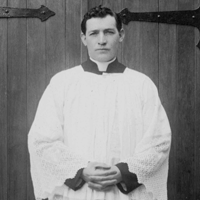 But our story really begins in 1910 with the appointment of Father Thomas Heditch as rector of the new parish of Palmers Green. “The Tablet” in its issue of 20th August 1910 reported:-
But our story really begins in 1910 with the appointment of Father Thomas Heditch as rector of the new parish of Palmers Green. “The Tablet” in its issue of 20th August 1910 reported:-
“Palmers Green – The troubles of Palmers Green grow. Not only are they without a church but they are without even a foothold of any sort, the Catholics of Palmers Green. A house was hired, Mass was said, jaundiced neighbours complained and lessors discovered that a covenant of the lease barred use of the house for religious worship. Now the difficulty arises how to find even a house, not to say the site for a church, so Father Heditch is in trouble crying in the wilderness of Palmers Green”.
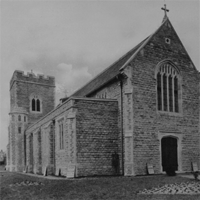 At this point it is appropriate to include some of the memories of Cecil Hughes who, with his family, had been resident in the area for some time. He wrote as follows in 1960 in celebration of the golden jubilee of the parish under the title:
At this point it is appropriate to include some of the memories of Cecil Hughes who, with his family, had been resident in the area for some time. He wrote as follows in 1960 in celebration of the golden jubilee of the parish under the title:
We were children then
“The tenth of July 1910 was a Sunday and Father Heditch said Mass that day at the house in Grovelands Road that was to do duty for some months as the parish church of Palmers Green.
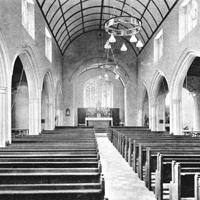 We were not there long but amongst my recollections are of two men and the bell. One of the men was Sydney Joseph Carreras, a veteran doorkeeper who welcomed us warmly in the manner one associates more, alas, with the Free Churches than with our own and who did his job faithfully to the last.
We were not there long but amongst my recollections are of two men and the bell. One of the men was Sydney Joseph Carreras, a veteran doorkeeper who welcomed us warmly in the manner one associates more, alas, with the Free Churches than with our own and who did his job faithfully to the last.
He died on duty, in the porch of St. Monica’s at the half-past nine Mass on Palm Sunday 1927.
The other man was Joseph James Gamage who took up the collection (such as it was) with an almost ducal dignity. His death, too, was memorable to those of us who served the altar in those days for it was one of those rare occasions when priest and servers went to the house (50 The Mall) with holy water and then, all vested in cassocks and cottas and with the processional cross escorted the body to the church.
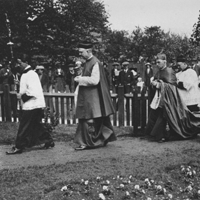 The bell, of course, was the one used at Mass but although no doubt very similar to the one at Wood Green, it sounded so different in the small space – just two sitting rooms knocked into one. The congregation hardly numbered fifty but we certainly hadn’t that many chairs so the children sat on the floor right in front, a yard from the priest. And the bell was very close!
The bell, of course, was the one used at Mass but although no doubt very similar to the one at Wood Green, it sounded so different in the small space – just two sitting rooms knocked into one. The congregation hardly numbered fifty but we certainly hadn’t that many chairs so the children sat on the floor right in front, a yard from the priest. And the bell was very close!
I’m afraid we didn’t get on very well with the neighbours. It can’t have been the bell but perhaps the hymns we sang were the wrong sort to make us popular in Grovelands Road -or perhaps it was our plain popery. Anyhow, we soon had to move. Thus it was that early in 1911 we found ourselves in a larger house standing in its own grounds in Green Lanes opposite St. John’s Church, named Hazelwood House, a stone’s throw from our present church. We were the last tenants – shops are there now.
 Fr. Heditch, however, was a sick man and in the spring of 1912 he went on pilgrimage to Lourdes, a pilgrimage which was far from being the streamlined travel agency arranged sort of affair that is normal in 1960. He never came back to us and on June 29th our new rector came – that giant of purposeful drive and energy, Fr. Gallagher.
Fr. Heditch, however, was a sick man and in the spring of 1912 he went on pilgrimage to Lourdes, a pilgrimage which was far from being the streamlined travel agency arranged sort of affair that is normal in 1960. He never came back to us and on June 29th our new rector came – that giant of purposeful drive and energy, Fr. Gallagher.
Those who knew him only in his declining years can form no idea of his former energy and those of us who knew him then can never forget it. For eleven years until his serious illness of 1923 he never rested, never tired. He did everything.
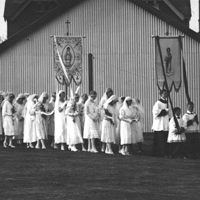 Within a year he had bought land which the owners (Barratt’s the Sweet makers of Wood Green) didn’t want to sell, put up a temporary church that lasted till 1930 when it had to be taken down to make room for our new hall, started a school and completed all the preliminaries for our new church which was opened by Cardinal Bourne on the feast of St. Monica in 1914. The chalice used on that occasion was given by the Cardinal to Fr. Gallagher with a letter written in his own hand which was always kept in the chalice case. One day – in 1925 I think it was – a casual thief walked in before Mass and went into the sacristy just as Fr. Gallagher had left it after putting the chalice, still in its case, on the vestment press. I was a little late he came out as I went in. Of course we never saw the chalice again; but its replacement was the gift, anonymously at the time, of the late Theodore Singer whose other gifts, also made anonymously, included the mosaic work in the Sacred Heart chapel and its stained glass window.”
Within a year he had bought land which the owners (Barratt’s the Sweet makers of Wood Green) didn’t want to sell, put up a temporary church that lasted till 1930 when it had to be taken down to make room for our new hall, started a school and completed all the preliminaries for our new church which was opened by Cardinal Bourne on the feast of St. Monica in 1914. The chalice used on that occasion was given by the Cardinal to Fr. Gallagher with a letter written in his own hand which was always kept in the chalice case. One day – in 1925 I think it was – a casual thief walked in before Mass and went into the sacristy just as Fr. Gallagher had left it after putting the chalice, still in its case, on the vestment press. I was a little late he came out as I went in. Of course we never saw the chalice again; but its replacement was the gift, anonymously at the time, of the late Theodore Singer whose other gifts, also made anonymously, included the mosaic work in the Sacred Heart chapel and its stained glass window.”
The New Church!
With the appointment of Fr. Patrick Gallagher as rector of the new parish in1912 things certainly began to move. Having purchased the site at the junction of Stonard Road and Green Lanes a temporary tin church was erected and Hazelwood House in Green Lanes was vacated. On Friday 20th June 1913 His Eminence Cardinal Bourne laid the foundation stone of the new Catholic church in the presence of about 500 people.
It was announced that the new church would have accommodation for 400 to 450 People and would be placed under the patronage of Saint Monica. Palmers Green is almost unique as, with the exception of the Augustinian Priory at Hoxton, it is the only parish in the Westminster Diocese to be dedicated to St. Monica. When choosing a patron saint the normal procedure is for the Parish priest to refer a proposed dedication to the ‘Ordinary’ of the diocese but there is nothing to prevent a parish priest making his own suggestion and probably Fr. Gallagher had done so.
The work of building the new church and presbytery occupied almost a year and the official, opening on Monday 4th May 1914 by Cardinal Bourne was enthusiastically welcomed by a gathering of nearly 600, including 40 clergy. The “Universe” reported the “strenuous efforts which Fr. Gallagher and his Congregation have been making to erect a permanent home for the Blessed Sacrament were thus crowned. The rapidity with which the church has sprung up is symbolic of the quickly-growing Catholic population of Palmers Green who now reach 500”. The “Bowes Park Weekly News” was enthusiastic about the structure – “The new church is a decided ornament to the district. It is solidly and simply built of stone and the square tower is a majestic feature. The church is not very large, seating about 400, but the interior has a most pleasing effect and the architect has every cause to be proud for, truth to tell, it is not every new church that can be called artistic. At St. Monica’s there is no meretricious adornment, the style is eminently in keeping with the grandeur and simplicity of the Roman Catholic faith”.
The church together with the presbytery was built for £6,600 including the cost of the site. About one-third had been collected, leaving a debt of some £4,000 but the interest on that sum had been guaranteed by some of the parishioners.
The ceremonial opening was impressive. The Cardinal presided at Mass which was celebrated by Abbot White assisted by Fathers Cheeseman and Tuohy, the music was rendered by a priests’ choir under the direction of Fr. Wall. Mgr. Grosch preached the sermon which, it was reported, “was of that style of simple eloquence in which the practised dialecticians of the Roman Church excel, the style which gives evidence of ability to uphold the faith before any concourse, critical or uncritical, faithful or sceptical”. – (Bowes Park News).
In 1920 Fr. Gallagher attended the Passion Play at Oberammergau and was understandably impressed by the wood carving industry there. He promptly ordered the Sacred Heart and Lady altars, statues of St. Joseph and St. Monica, the confessional boxes and a very handsome pulpit with an effective sounding board. The work was delivered in 1921 when he was on holiday and on his return he was distinctly annoyed to see that the curate, Fr. Gordon, had put the pulpit on the Epistle (right) side of the church, thereby indicating that the parish had apparently been upgraded to a bishopric! (post Vatican II parishioners would never have noticed). The pulpit was taken down at once and installed on the Gospel (left) side where it remained for many years.
Several alterations have been made since the summer of 1914 notably the beautiful mosaic work which adorns the Sacred Heart chapel and the five stained glass windows installed about the same time. The Sacred Heart Chapel, which had been correctly placed in the south-west corner of the church, was an anonymous gift by an early member of the parish, Theodore Singer. The walls are lined with mosaic in various patterns including two angels bearing mottoes “Behold this Heart” on the left and “Which has so loved men” on the right The traditional Sacred Heart statue is in the centre of the altar surrounded by intricate carved patterns. There is a coloured wooden pane on each side of the statue; the one on the left shows St. Peter receiving from Jesus the keys of the Church whilst the right hand panel illustrates Jesus showing his Heart to Sister Margaret Mary in the chapel where she lived and worked. The stained glass window bears the inscription “Suffer little children”. Next to the window is the door to the bell tower, which is reached by a stone spiral staircase.
The stained-glass windows, three on the south wall and two on the north, were made by F. Mayer of Munich and London and (as stated at the foot of the first) “were erected in gratitude to God for his gracious blessings and tender mercies”.
The Stations of the Cross are carved in oak and were originally framed. The great detail, the facial expressions and the colouring are said to encourage penitents to “do” the Stations if only to look at the pictures.
On the right hand side of the entrance porch of the church is a stone plaque giving the names of the parish priests of St. Monica’s since 1910, namely:-
1910 Thomas Heditch
1912 Patrick Gallagher
1957 Reginald Crook
1964 Raymund Geraerts
1979 Robin Whitney
1994 Brian Creak
2004 Roger Taylor
2008 Shaun Lennard
2017 Mehall Lowry
In 1980 the church needed a new roof and in 1984, it became necessary for the external stonework to be repaired and protected. At the same time all the interior stonework was cleaned, the side walls were cleaned and painted and various repairs were done. Also in 1984 an anonymous donor gave a carpet for the centre aisle and in front of the altar rail and also paid for the sanding and sealing of the parquet block floor. Another anonymous donor provided the new coloured window installed in the chancel in place of the plain glass which was originally behind the High altar and was in recent years hidden by a curtain forming a background to a large crucifix which has now been moved to the wall adjoining the sacrisity. The window is by the Maltese artist Carmel Cauchi.
With the parish so firmly established, and the church debt repaid many years before, the time was ripe for St. Monica’s Church to be consecrated. Fr. Whitney made the necessary arrangements and on Sunday 6th October, 1985 we were honoured by the presence of Cardinal Basil Hume, Archbishop of Westminster, to perform the ceremony of the consecration. It was a momentous occasion and the ritual was carried out with great dignity, the relics placed in the altar being fragments of the bodies of two early martyrs, St.Constantia and St. Jucunda and of St. Pius X. The Cardinal, in his address, was kind enough to praise both the altar serving and the singing of the choir, and indeed the general arrangements for his visit. It was certainly a great day in the life of our church.
By 1997 it had become obvious that further work needed to be done to accommodate the requirements of the new liturgy. The Tabernacle was moved back to the ‘east’ end of the church. The presidential chair placed nearer to the people, a new sanctuary floor was laid, a new altar, a new lygilium, and a new font were installed, the pews were sanded down to reveal their original lighter colour, the walls, floors, mosaics, Stations of the Cross, statues were cleaned – repainted where necessary and a new lighting system designed. It was a massive undertaking, but the final result has been much admired.
Space, is fast becoming a problem at St. Monica’s, with a wonderful, growing, congregation the church is often over full – but that is a ‘problem’ we are all too happy to have! We are blessed with a marvellous congregation of all ages and a beautiful building in which to give glory and praise to God.
Deo Gratias et Maria